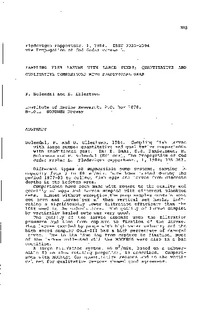| dc.contributor.author | Solemdal, Per | |
| dc.contributor.author | Ellertsen, Bjørnar | |
| dc.date.accessioned | 2008-08-06T09:23:04Z | |
| dc.date.issued | 1984 | |
| dc.identifier.issn | 0333-2594 | |
| dc.identifier.uri | http://hdl.handle.net/11250/115114 | |
| dc.description.abstract | Different types of submersible pump systems, ranging in
capacity from 3 to 60 m^3/min, have been tested during the
period 1977-83 to collect fish eggs and larvae from discrete
depths in the Lofoten area.
Comparisons have been made with regard to the quality and
quantity of eggs and larvae sampled with different plankton
nets. Almost without exception the pump samples contain more
cod eggs and larvae per m^3 than vertical net hauls, indicating
a significantly lower filtration efficiency than the
100% used in the calculations. The quality of larvae sampled
by vertically hauled nets was very good.
The quality of the larvae depends upon the filtration
pressure and time from capture to fixation of the larvae.
Thus larvae sampled by pumps with high water velocity and the
high speed sampler Gulf-III had a high percentage of damaged
larvae. Due to the time lag from capture to fixation, most
of the larvae collected with the MOCNESS were also in a bad
condition.
A large filtration system, 60 m^3/min, based on a submersible
80 cm slow-rotating propeller, is described. Comparisons
with MOCNESS for quantitative reasons and to the vertical
net for qualitative reasons showed good agreement. | en |
| dc.format.extent | 710695 bytes | |
| dc.format.mimetype | application/pdf | |
| dc.language.iso | eng | en |
| dc.publisher | Havforskningsinstituttet | en |
| dc.relation.ispartofseries | Flødevigen rapportserie | en |
| dc.relation.ispartofseries | 1, 1984 | en |
| dc.title | Sampling fish larvae with large pumps; quantitative and qualitative comparisons with traditional gear. In: The propagation of cod Gadus morhua L.: an international symposium, Arendal, 14 - 17 June 1983 | en |
| dc.type | Conference object | en |
| dc.source.pagenumber | 335-364 | en |
